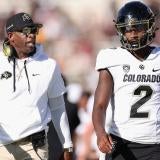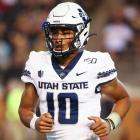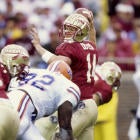The Super Bowl is so hot right now, but technically, with the Senior Bowl over and done with, we're in NFL Draft season. So it's time for a Derek Zoolander and Hansel McDonald type collaboration.
Thanks for continuing to read after a Zoolander reference in 2020.
In Miami for Super Bowl week, our very own Ryan Wilson tracked down Chiefs rookie running back and former Utah State star Darwin Thompson to talk ball, and the springy scat back compared quarterback prospect (his former teammate) Jordan Love to his current teammate, Patrick Mahomes. Hmmm.
While I think that comp might be a little too optimistic, there are certainly parallels to the 2020 draft class in players who will be on the field in the Super Bowl.
Before you scroll down, I must provide the disclaimer that I am not insinuating these prospects will become as good as the current NFL players in each comparison. Those listed below are simply the prospects in this year's draft class who most resemble the stars in this year's Super Bowl.
Patrick Mahomes
Comparison: Jordan Love, Utah State
Love isn't as talented as Mahomes. There. Got that out of the way. No one is right now. But, and this is important, Love is capable of doing Mahomesian things on the football field thanks to effortless arm talent that doesn't require a sturdy base and perfect fundamentals to absolutely rip the football deep down the field.
There's some nuance to his passing ability too, as Love demonstrated pretty touch throughout his illustrious career at Utah State, and he fits the mold of the modern-day quarterback who doesn't resemble your 55-year-old knee brace-wearing uncle while scrambling. Love will give you three-quarter deliveries, strikes on the run across his body, overly aggressive connections that somehow are fit into receiver's hands deep downfield.
And yes, there'll be some misses too like some clearly confused-by-the-coverage throws, and some passes in which you wonder why he made such a bold decision.
Eric Fisher
Comparison: Matt Peart, UConn
Get to know this name. And no, Peart won't go in the first round like former No. 1 overall pick Fisher did. Heck, it would actually be a surprise if he made his way to the second day of the draft.
But at nearly 6-foot-7 and 310 pounds with vines for arms and borderline elite athleticism for the tackle position that allows him to mirror like a veteran, Peart has the on-field ingredients to become Fisher 2.0 at the next level. When Fisher entered the league out of Central Michigan in 2013 and rocketed up boards all the way to the top of the draft, everyone agreed he had franchise tackle athletic traits but needed to beef up and get stronger. That's precisely how I view Peart right now.
Tyreek Hill
Comparison: Henry Ruggs, Alabama
Hill is kinda like the Mahomes version of the receiver position. There's really not anyone strolling this planet right now with his raw talent. Hill is the twitchiest player in the NFL and has Olympic-level speed. Plus, he can go up and get it, which is another reason he's been such an illustrious play-maker during his time with the Chiefs.
Ruggs has Hill characteristics. First off, he's stupidly fast. I mean, he made everyone in the SEC look like they were running in mud during his time at Alabama. Secondly, he's not just a linear track star with a helmet on. Check Ruggs running routes,and you get glimpses of Hill-like change of direction. And there were a few instances of outstanding ball tracking too. Depending on which link you click, Hill ran somewhere in the 4.21-4.29 range at his West Alabama pro day in 2016, and I don't think one scout in Indianapolis nor any draft analyst will be surprised if Ruggs is clocked in the 4.2s at this year's combine.
Travis Kelce
Comparison: Adam Trautman, Dayton
Kelce wins first and foremost because he's a rare athlete. His route-running ability is special because of the flexibility in his hips and ankles and the explosion he creates with his lower half.
And yes, a tight end from Dayton, is the closest thing to Kelce in this draft class. Like it was another game against Stetson or Robert Morris, Trautman repeatedly lost linebackers and safeties with sudden routes at the Senior Bowl, and his film for the Flyers, is well, yeah, it's a joke. I mean, he was by far the most talented, easy-to-spot player in every 2019 Dayton contest I watched.
Chris Jones
Comparison: Javon Kinlaw, South Carolina
Jones is the big man who gets everything going up front for Kansas City and is set for an enormous payday this offseason. They're nearly the exact same size -- both around 6-6 and 310 pounds -- with tentacle-like arms, but that's not the main reason for this comparison. Never is.
Like Jones, Kinlaw is a master with his hands, defeating blocks at will to get upfield to pressure quarterbacks or down the line of scrimmage to corral running backs. Also, Jones and Kinlaw are high-level athletes despite their mammoth frames, and their electric first steps routinely put them in advantageous situations against interior blockers. Jones famously was invited to the 2016 NFL Draft, but somewhat ridiculously fell to the second round and has been a star in Kansas City from his rookie season. Actually, his lack of major production likely precipitated his fall out of Round 1. And guess who else doesn't have basic statistics of a "normal" first-round pick? Yep. Kinlaw.
Tyrann Mathieu
Comparison: Terrell Burgess, Utah
Mathieu is a 5-9, 186-pound defensive back who's had a colossal impact on the Chiefs secondary this season. Mathieu was a multi-faceted play-maker before tweeners were "cool" in the NFL, and now we're at the point in which I can't go more than one article without mentioning how the league is becoming "positionless" like the NBA.
While Mathieu is a little flashier with sharper instincts, Burgess was the utility man in Utah's studly secondary over the past few seasons, carrying out a variety of duties and excelling at each. At just under 6-0 and 192 pounds, Burgess demonstrated the ability to range from the deep middle, constantly get his hat to the ball carrier as the last defender in the box regardless of the direction of the run, and lock down running backs and slot receivers in man coverage.
Both Mathieu and Burgess play much larger than their size and are ideal defensive components to have in today's matchup-based NFL. They don't ever have to come off the field because they truly aren't liabilities in any area.
Frank Clark
Comparison: A.J. Epenesa, Iowa
Clark is a powerful defensive end with more athletic prowess than most 270-plus pound players at his position, and he acclimated quickly to the NFL thanks to a polished collection of pass-rushing moves.
Add 10 pounds, and that's basically the scouting summary on Epenesa. You see 6-6 and 280 pounds on film, and you think "OK, he's going to be a bull rusher who's strong against the run." Then you see the Iowa star bend the edge on one play to generate pressure then swim back to the inside on the next pass play, leaving the tackle totally out of position, you think "OK, this guy's a stud."
Because of the weight difference, Clark does have more juice than Epenesa, and as prospects, Epenesa is probably a little stronger at the point of attack. But if you want a decently refined power rusher in this class, a defender with Clark-like characteristics, look no further than Epenesa.
Jimmy Garoppolo
Comparison: Anthony Gordon, Washington State
As a Washington State quarterback, you probably know what type Gordon is. He's a passer who gets it out quickly, mostly on underneath throws, and thanks to the variety of options at his disposal on every play, is pretty deft getting through his reads. But he doesn't have a huge arm and, from time to time (see: too often) writes checks with his brain that his arm can't cash. He's a quick-decision based quarterback. And does every quick decision you make in life turn out to be a good one? Exactly. The same goes for Gordon.
Garoppolo has become a better processor during his NFL career, but, he too hailed from a spread offense in college -- Eastern Illinois -- and was a quick-passing point guard before going to the New England Patriots. Don't be offended by this comparison, Jimmy G fans, but Gordon most resembles your guy in this draft class.
Nick Bosa
Comparison: K'Lavon Chaisson, LSU
There could be upwards of 25 pounds difference between Bosa and Chaisson, so anyone complaining about the comparison, I get your gripe from that perspective. But of course these are style comparisons, and Chaisson is almost as advanced as a pass rusher as Bosa was as a prospect. Dead serious.
From a speed-to-power bull rush to a one-arm straight-arm and counter back to the inside, to a classic swim move or a simple speed rush with tremendous bend and dip around the corner, Chaission looks like a miniature Bosa on the field. And, like the probable Defensive Rookie of the Year, the LSU star plays with an electric get off, and his motor always hums.
Richard Sherman
Comparison: Bryce Hall, Virginia
Sherman has enjoyed a Hall of Fame career thanks to impeccable instincts, zone savvy and rare athleticism for a huge cornerback with long arms.
At Virginia, the 6-1, 200-pound Hall had an All-American season in 2018 thanks to many of those same principles. He recorded a whopping 21 pass breakups with two picks by being a step ahead of everyone else on the field and flashing his dangerous combination of length and awareness when the football was arriving to make a play on it.
Sherman's hips are more oily, but if you're shopping for a perimeter zone cornerback in this draft with the size to match up with those large alpha receivers in the NFL, Hall's the one for you.
George Kittle
Comparison: Devin Asiasi, UCLA
Like Kittle in 2016, Asiasi enters the pre-draft process without much fanfare at all. So that similarity is good for the comparison. Also like Kittle, Asiasi has deceptively awesome athletic talent. In my notes on the UCLA tight end, I wrote "super-smooth running his routes and is decently impressive after the catch. Large catch radius and catches with his hands."
So right there, you know Asiasi can get open, and he's a threat to spring the big play after the catch. Kittle-like. Of course Kittle has become the most complete tight end in the NFL thanks to Kirk Ferentz drilling him on blocking for years at Iowa, and I don't feel like I'm going out on a limb writing that Chip Kelly didn't emphasize blocking nearly as much for his tight ends during Asiasi's time in Southern California.
But, he's useful in space as a blocker and is listed at 279 (!), so the raw tools are there for him to be effective in that area. Just remember where you read it first if, like Kittle, Asiasi goes in the middle of the draft and then becomes ...OK, he's probably not going to be an elite tight end in the NFL by Year 3, but there are quite a few striking similarities between the two.
Dee Ford
Comparison: Josh Uche, Michigan
Ford came out of Auburn as mainly an outside speed rusher who flashed an inside move just frequently enough to scare offensive linemen and keep them from over-setting in pass protection. Because he was a little shorter than most edge defenders, he naturally converted low-center-of-gravity speed to power.
All of that applies to Uche, who was the best edge rusher at the Senior Bowl this year. And on film with the Wolverines, he repeatedly drove back much bigger offensive linemen when he wasn't bending past them on the outside or exposing them with a nasty inside move. Uche gives you more positional versatility than Ford, but the latter is a little bigger and more stout setting the edge. Like Ford, don't be surprised when Uche ultimately lands in the first round.
DeForest Buckner
Comparison: Jordan Elliott, Missouri
I remember scouting Buckner when he was a prospect at Oregon in 2015 and being impressed with how well such a tall interior defensive lineman utilized his hands to keep blockers off his frame but wondered if his pass-rushing moves took too long for him to consistently disrupt in the run game and pressure the quarterback.
Turns out, his martial arts at the point of attack were plenty quick enough, as he's been one of the most underrated defensive linemen in the game since stepping on the field for San Francisco as a rookie. I get similar vibes with Elliott, who'll measure in around 10-20 pounds heavier than Buckner but flashes an array of pass-rushing moves on the inside and moves better than you'd expect for a 6-4, 315-pounder.
Joe Staley
Comparison: Jedrick Wills, Alabama
Staley is the technician's technician, a tackle who's had a long, highly productive career because the fundamentals are second nature to him. He plays low. His punch timing is perfect. He resets his hands quickly if they're swatted away. Offensive line coach's dream. Oh, and he's just athletic enough to get to dynamic outside rushers and packs a mean punch in the run game.
Wills is essentially the same player. Neither are truly "dancing bears" on the outside, but like Staley, Wills crouches outstandingly in pass protection and is robotic -- a good thing -- with his punches that jolt defensive linemen. He's very aware of stunts, never panics and is a bulldozer in the run game.





















